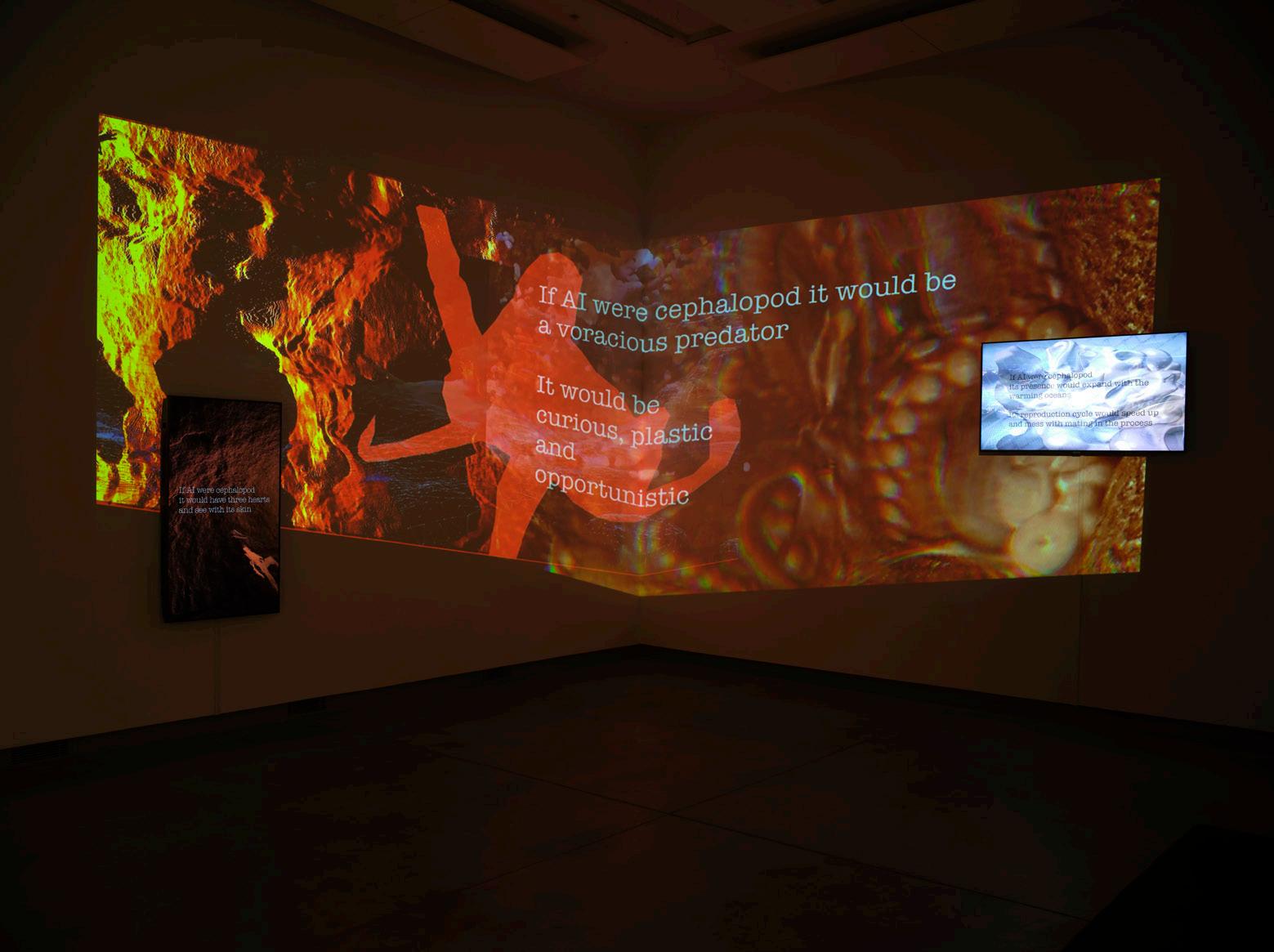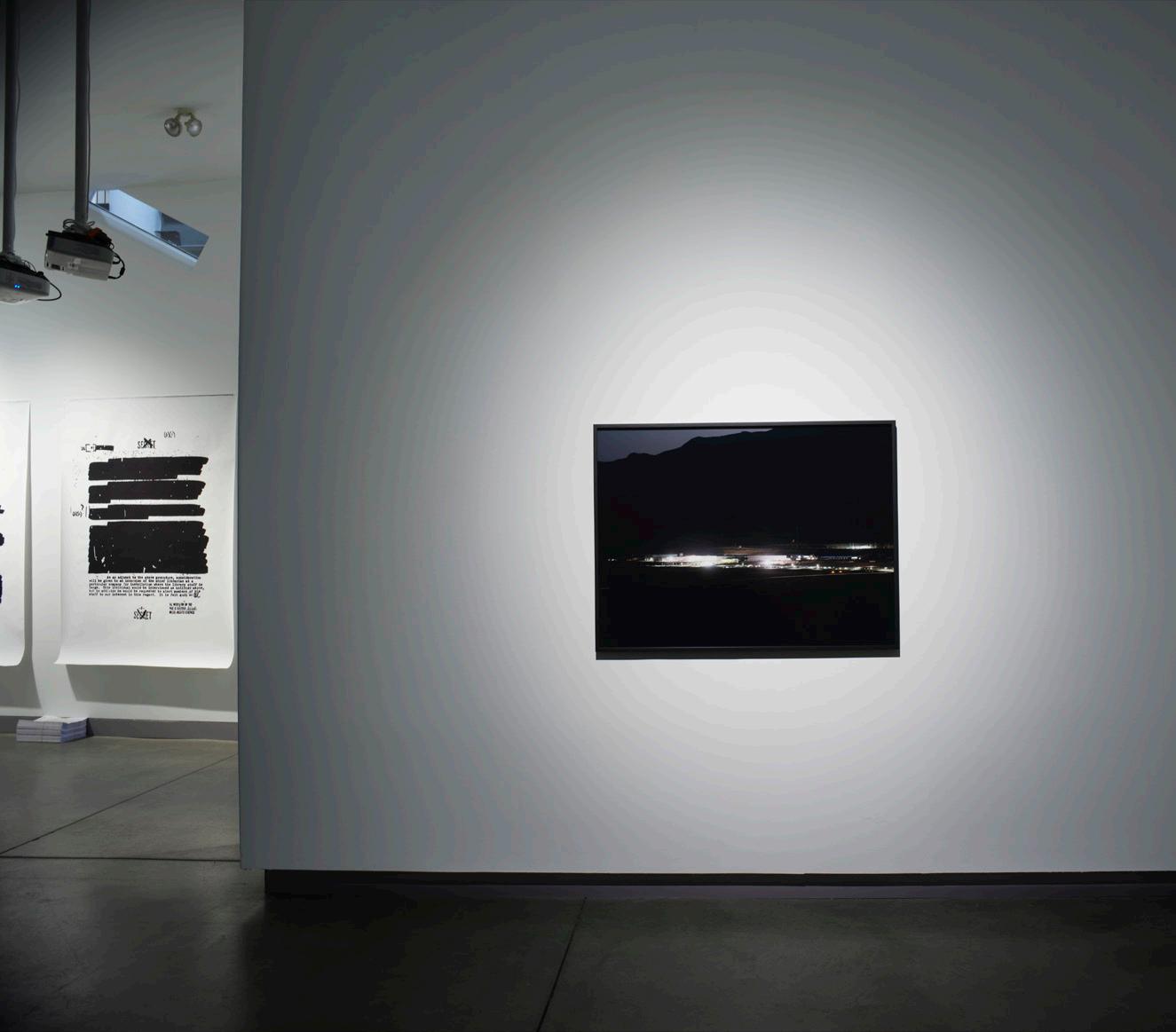
10 minute read
MONITOR: SURVEILLANCE DATA, AND THE NEW PANOPTIC
38
YAZAN KHALILI, Medusa, 6 channel video installation, 21:57 min., 2020.
Advertisement
39
MONITOR: SURVEILLANCE, DATA, AND THE NEW PANOPTIC
JULIE POITRAS SANTOS DIRECTOR OF EXHIBITIONS, ICA AT MECA&D
Surveillance has become an inescapable part of daily life. Phones record our every movement, call, and contact; cameras record our passage along the street; online sites record our interests and habits in order to engage in “better product placement.” Collected data streams to fusion centers, and while predictive policing targets specific communities for more intensive monitoring, Siri and Alexa listen in. Through social media we surveil each other and ourselves. Monitor: Surveillance, Data, and the New Panoptic explores the ways in which our lives are being influenced and determined by visible and invisible actions of “watching over.” The works in the exhibition reveal, challenge, upend, or complicate the power balances inherent in these dynamics of oversight. The artists take up questions raised by increasingly networked and pervasive globalized systems of monitoring in numerous ways, tracing historical trajectories as much as contemporary revelations, in order to provide us with perceptual and historical tools for assessing our current, pervasive technological supervision.
Because many surveillance processes are structured to be invisible, we often find out about them retrospectively, through data breaches, investigations, or leaks. In mid-July of this year, reports from multiple national and international news media organizations revealed that tens of thousands of phone numbers globally were targeted, and in some cases hacked, by Pegasus, a spyware product of the billion-dollar Israeli surveillance company NSO Group. In a well-publicized leak in 2013, former computer intelligence consultant for the CIA and NSA, Edward Snowden, revealed numerous global surveillance programs, prompting a conversation about national security and individual
40
privacy. No citizen is free of monitoring; recent documents published in 2020 from the Blue Leaks trove revealed the extent to which the FBI monitored protests that arose after George Floyd’s murder, collecting and recording data throughout the country.
Thirty minutes south of Salt Lake City in the desert town of Bluffdale, housed by four large concrete structures, the National Security Agency’s Utah Data Center is one place where masses of collected data are stored. While we do not know exactly what data is stored there, we know it is one of the eight largest data centers in the world; the facility uses about 65 megawatts of electricity to operate per year. 1 Many articles were written about the Data Center when construction began in 2012, but it has since faded from public attention. Created in the decade after 9/11 when increased surveillance in the United States became progressively normalized, the Data Center is designed to store and process the yottabytes of information captured in the NSA’s digital dragnet; it intercepts, deciphers, analyzes, and stores vast swaths of the world’s communications collected from satellites and passed through the underground and undersea cables of international, foreign, and domestic networks. 2
Trevor Paglen’s photograph, National Security Agency Utah Data Center, Bluffdale, UT (2012), captures the facility under construction, revealing the critical infrastructure brightly lit like an airport at night. Long known for his work that explores the legacies of surveillance technology, Paglen has systematically made visible the national project of surveilling citizens by revealing its architecture and physicality. While one can now plainly see a daytime view of the nondescript, white-roofed buildings arranged in a row within a kidney-shaped ring road on Google Earth, Paglen’s street-level image of the anonymous buildings glowing within the shadow of the Oquirrh Mountains reminds viewers of the enormity of these collection processes and how they are so often kept out of the way, their operations occluded or fenced from our view.
In contrast to this contemporary oversight, the work of Kapwani Kiwanga looks toward the very troubled beginnings of our country’s founding. Kiwanga’s abstract sculptural forms stand like distant markers pointedly in the galleries, drawing the viewer toward them. Lit from within, Glow 2 and Glow 3 seem to resist you coolly at first viewing and to withhold their meaning. In making these works, Kiwanga drew on extensive research of early “lantern laws” in the United States. As described by scholar Simone Browne, lantern laws were 18th century laws in New York City that demanded that Black, mixed-race and Indigenous enslaved people carry candle lanterns with them if they walked about the city after sunset without the company of a white person. The law prescribed various punishments for those that didn’t carry this supervisory device.3 Browne’s work has been critical in revealing the history of these pernicious
41
methods of oversight. Kiwanga follows this lineage of surveillance, positioning it in relation to blackness in America, from its roots in slavery to the role that technology performs today. The works address a history of forced visibility, as well as that of strategic concealment. 4
A few works in Monitor: Surveillance, Data, and the New Panoptic explore the archive in ways that retell collective histories, and give the viewer greater context for contemporary surveillance activities. Through a 20-page printed tabloid, Ann Messner regards the history of library surveillance as a besieged history of free and open access to knowledge in the US. Beginning with the first public library in the country, her work reveals the history of a public library as a public space; one, she notes, that “cannot be separated from the struggles for civil and human rights, of class and labor struggles, for religious and secular intellectual freedom and the right to enquire and question.” 5 Distributed freely from the ICA and throughout the state via the Maine State Library, the tabloid travels in its readers’ hands, and amasses a collection of evidence that points toward systematic use of surveillance and censorship to exert social control and reinforce belief systems and boundaries. In presenting this history, Messner reflects on the library as a living archive, one that is subject to changes and challenges over time.
Through photographic still-lives, archival appropriation, and investigation, Christopher Gregory-Rivera examines the bureaucratic residue of a 40-year-long secret surveillance program of the Puerto Rican people begun in the 1930s. Gregory-Rivera explains, “From the 1930s until 1987, the Puerto Rican Police Department in conjunction with the FBI conducted a massive secret surveillance program in Puerto Rico. Its main goal was to suppress any groups or individuals who sought independence from the United States. This program tracked around 150,000 citizens and is one of the longestcontinuous surveillance projects conducted by the U.S. Government on its own citizens.” 6 The resulting project, Las Carpetas (2014–), presents Gregory-Rivera’s extensive documentation of these archival materials—including letters, personal objects, photographs, and books. The large-scale photographs offer the viewer an immersive, even overwhelming, image. As a counterhistory to the way many understand that period of time, Las Carpetas is a political act. Rescuing, photographing, and displaying the contents of the surveillance files allows individuals to retell their histories, even as they question how we know and remember our past.
In contrast to the visual volumes presented by older archives, one salient aspect of current surveillance is the sheer mass of data that contemporary collection agencies capture and store. Margaret Laurena Kemp and Abram Stern’s collaborative video project, Unburning (2021), explores the possibility of scraping metadata from volumes of FBI
42
surveillance footage taken of the 2015 Baltimore uprisings after the death of Freddie Gray. Is it possible to “unburn” this data and reinhabit the resulting gaps with agency and power? Gray died on April 19 from injuries sustained while being transported in a police van; the protests against his mistreatment and inadequate answers from law enforcement grew over the course of that April and became violent. Soldiers from the Maryland Army National Guard were called in to control the protesters, and familiar sounds of helicopters thumped overhead. Freely available online, Kemp and Stern use aerial surveillance footage of that protest in combination with video from a durational performance by Kemp at the Montalvo Center for the Arts in 2017. Inspired by her quest to perform “The Souls of Black Folk” by W.E.B. Du Bois, the durational performance was captured solely by the audience on their cellphones. Their combined work, Unburning, as a whole, asks challenging questions about endurance and the indelible mark of surveillance on real bodies and lives.
Yazan Khalili’s video installation, Medusa (2020), crafted from six monitors suspended from the ceiling, confronts the nuances of contemporary facial recognition technology by considering a mask of Medusa in a museum. The six monitors are cracked and covered with materials that interrupt the viewing and reinforce the physicality of the screen. Khalili’s work reflects how technology itself is not an untouchable abstraction. As a human invention, it hosts our respective weaknesses. It relies on images, histories, codes, decisions, regulations and glitches that, however complex, are mired in bias and insufficient data. 7 Investigating the poetic potential of gaps and failures within this technology, Khalili offers potential forms of resistance or response to this pervasive gaze, evoking what Simone Browne has called “practices of freedom” that one might exercise under such broad and pervasive supervision.
In their immersive video installation, If AI Were Cephalopod (2019), the artist collective Orphan Drift explores the boundaries of machine and human vision, asking viewers to consider radically new ways of understanding Artificial Intelligence (AI). In contrast to the poetics of Khalili’s work which interrupts the experience of the screen, Orphan Drift invites viewers into an immersive video installation, drawing viewers past the architecture of the images to inspire our speculative imagination. Considering AI from the position of a cephalopod, Orphan Drift engages with embodied cognitive science, reinforced learning models, and radical anthropology. Their multiple channel installations suggest possibilities of expanding and inhabiting other systems of perception and proprioception. Motivated by concern as much as fascination, Orphan Drift writes that their “imagining into the octopus’s distributed consciousness is underpinned by a desire to resist the evolution of AI as a surveilling and predictive modelling tool; rather to embrace a plastic, opportunistic, fluid, protean otherness
43
embodied by the octopus.” 8 Their recent partnership with Etic Lab in Wales allows Orphan Drift’s speculative proposal to be explored in actuality with an ocean-like mesocosm and a living cephalopod.
Challenging us to be active watchers in the world, the works in Monitor: Surveillance, Data, and the New Panoptic trace long surveillance histories and a surveilled present, reinforcing the notion that these modes of vision and power must be recognized and remembered to contest them, rendered legible in order for us to perform the basic tasks of questioning or reimaging them. In becoming more alert to the gazes that monitor our lives, we are empowered to look back at them, enacting our own practices of freedom and resistance and, in process, transforming them.
1. Mukul Taneja, “The 8 Largest Data Centers in the World in 2020.” Analytics Vidhya, September 2, 2020, https://www.analyticsvidhya. com/blog/2020/09/8-largest-datacenters-world-2020/ (accessed September 13, 2021)
2. James Bamford, “The NSA Is Building the Country's Biggest Spy Center (Watch What You Say)” March 15, 2012, https://www.wired. com/2012/03/ff-nsadatacenter/ (accessed September 13, 2021).
3. Claudia Garcia-Rojas, “The Surveillance of Blackness: From the Trans-Atlantic Slave Trade to Contemporary Surveillance Technologies,” Truthout, March 3, 2016, https://truthout.org/ articles/the-surveillance-ofblackness-from-the-slave-trade-tothe-police/ (accessed August 28, 2021).
4. Kapwani Kiwanga, Kapwani Kiwanga: Safe Passage, organized by Yuri Stone, MIT List Visual Arts Center, https://listart.mit. edu/exhibitions/kapwani-kiwanga (accessed August 28, 2021)
5. Ann Messner, statement on the work, 2021
6. Christopher Gregory-Rivera, statement on the work, 2021
7. Yazan Khalili, Yazan Khalili: Medusa, Museum of Contemporary Art Toronto, https://moca.ca/ exhibitions/yazan-khalili-2020/ (accessed August 30, 2021).
8. Orphan Drift, https://www. orphandriftarchive.com/ (accessed September 3, 2021)


ORPHAN DRIFT, If AI Were Cephalopod, 4 channel video installation, 11 min., 2019.
ANN MESSNER, the free library and other histories, posters, 60 ✗ 96 in. (each), 2018.
/p. 46–49 ORPHAN DRIFT, If AI Were Cephalopod, 4 channel video installation, 11 min., 2019.



48
49

TREVOR PAGLEN, National Security Agency Utah Data Center, Bluffdale, UT, C-print, 36 ✗ 48 in., 2012. Courtesy of Colby College Museum of Art. Museum purchase from the Jetté Acquisition Fund 2013.530.







